
Found him!
Take a Lumia 920 and slap on an AMOLED screen, and you have a Lumia 925 or 928. Take a Lumia 920 and slap on an AMOLED screen and a hulking great camera—now you have the Lumia 1020.
The Lumia 1020 is Nokia's new flagship Windows Phone. It's a mix of the familiar and the novel. Familiar are the phone's internals, sensors, and screen. There's the same dual core 1.5GHz Qualcomm Snapdragon S4 as found in the 920, 925, and 928. The same 4.5-inch 1280×768 AMOLED screen as the 925 and 928 with the same Gorilla Glass coating and "PureMotion HD+" that's supposed to reduce reflections, improve sunlight visibility, and ensure crisp 60Hz screen updates.

Out of the box, the Lumia 1020 has this rather handy sticker on the back that shows what everything is.
Even the design is very familiar. From most angles, it looks just like the Lumia 920. The body is seamless polycarbonate (black, white, or yellow) with a slightly curved black screen on the front. The right-hand side has a set of buttons: power, volume, and a camera button with half-press focus.
There are a few minor internal differences. The Lumia 1020 has 2GB of RAM instead of the 1GB found on the 920-series phones. It apparently contains a barometer, new to Windows Phone, in addition to the typical GPS/GLONASS, compass, accelerometer, and gyroscope. Slightly peculiarly, it eschews the built-in wireless charging support found on the 920 and 928, instead using a clip-on cover to provide wireless charging, similar to the 925.
But the point of the Lumia 1020 is the camera. If you don't care about smartphone cameras, the Lumia 1020 has nothing significant to offer above the 920 series. I don't think you'll ever notice the extra RAM or barometer.
That camera

If, however, you like taking photos with your smartphone, the Lumia 1020 is altogether more interesting.
Though the Lumia 1020 looks like a 920 in most regards, it has one striking difference: a great big bulge on the back where the camera is.
Small cameras—the kinds found in phones and point-and-shoots—have their imaging sensors measured in an honestly idiotic "inch" system that doesn't actually correspond to the size of the sensor itself. In the 1950s, the analog sensors used in TV cameras used glass tubes. These came in a wide range of diameters, and it's these diameters that are used to denote the size of the imaging sensors. However, the actual usable sensor size in these tubes was about two-thirds of the diameter.
Even though nobody uses video camera tubes any more, these smaller sensors retain the tube-based sizing policy. A sensor described as being 1/3.2", such as that found in the iPhone 5, has a diagonal not of 1 ÷ 3.2 = 0.3125 inches/7.9 mm but rather about two-thirds of that, 0.208 inches/5.28 mm. This isn't exact. The ratios vary, with the iPhone 5's sensor being about 0.233 inches/5.9 mm.
Under this historic, inaccurate, and downright anachronistic measurement system, the Lumia 1020 has a 2/3" sensor. This translates to a diagonal of about 0.444 inches/11.2 mm.
The sensor has a resolution of 7712×5360 for a total of 41.3 megapixels. The optical parts of the camera don't illuminate the corners of the sensor, however. Instead, it supports 16:9 images at 7712×4345 (33.6MP) and 4:3 images at 7136×5360 (38.2MP). Each pixel is 1.1 microns.
As is increasingly common, the sensor is back-side illuminated. Most imaging sensors use front-side illumination: like the human eye, photons have to pass through the sensor's wiring before reaching the photo diode itself. This arrangement is easier to manufacture and more physically robust, but the wires reflect some of the light falling on the sensor, reducing the low-light performance.
Back-side illumination constructs the sensor similar to that of a cephalopod eye, with the wiring behind the photo diode. This is more complex, but it allows more light capture. Apple has used back-side illuminated sensors since the iPhone 4; Nokia uses them in the 920 series' cameras, among others.
Megapixel myth... busted?
What's the point of this ridiculous resolution? We took a look at this question last year when we examined the Lumia 1020's spiritual predecessor: the Symbian-powered PureView 808. The PureView 808 also had a 41 megapixel sensor. Its sensor was slightly larger than the Lumia 1020's—a 1/1.2" sensor with a diagonal of about 0.56 inches/14 mm. But the PureView 808 used front-side illumination, as at the time there was no back-side illuminated sensor large enough.
The resolution allows two things. First, it allows for oversampling. Whenever you take a picture on the Lumia 1020, it produces a 5MP image. Each pixel in this image is created from data taken from several of the pixels on the sensor. This improves the image in a number of ways. It allows certain kinds of image noise to be averaged out (and hence removed), and it also results in better capture of fine detail.

You can crop from this...
The second thing is that it allows better digital zoom. Almost all smartphones, and many point-and-shoot cameras, have fixed focal length lenses. Usually, in the case of smartphones, it's also a fairly wide-angle lens. To "zoom," the phones simply crop the image captured by the image sensor to the area being zoomed into, then resize that image to match the sensor's native resolution. The result is that much of the image data has to be interpolated, synthesizing image data.

... to this, without having to interpolate.
On the Lumia 1020, however, digital zoom can crop the 41MP sensor output to 5MP—no need to upscale. At the highest level of zoom, this means that there can't be any oversampling. So it loses that advantage, but at intermediate zoom levels, some amount of oversampling is still possible.
Oversampling and digital zoom are both also available for video, allowing 4× zoom at 1080p and 6× zoom at 720p, all without upscaling.
In front of the sensor are a mechanical shutter and a stabilized lens assembly. A stabilized lens assembly was the big feature of the 920 series' cameras. The 1020's stabilization system is different to accommodate the greater weight of its larger lens assembly. The whole thing is mounted on ball-bearings, with tiny motors shifting the lenses around to counter the movement of the phone.
The main purpose of this is to let the 1020's shutter be held open for longer, letting more light onto the sensor without introducing blur. Nokia claims that exposures can be three to five times longer than would be possible without the stabilization system.
The lens system is somewhat prone to flare, as this series of comparison shots demonstrates. I think it seems a little worse than the Lumia 920, though it's not as bad as the iPhone 5. For smartphone cameras, there's honestly not a whole lot you can do about this kind of thing other than "don't let bright light hit the lens obliquely." The hoods that SLR users attach to reduce flare don't really exist for smartphone cameras.
To help more light get in, the camera also has a reasonably wide f/2.2 aperture.

Even with an f/2.4 aperture, the short focal length of the Lumia 1020's lens limits the amount of background blur, but in extreme situations, the bokeh isn't too bad.

Or, of course, you can blur the foreground a little and have the background in focus.
Finally, the Lumia 1020 follows the Lumia 928 in equipping its camera with a Xenon flash instead of the more common LED. Xenon flashes are brighter, and they emit their light more quickly than LEDs. The result is better illumination and a greater ability to "freeze" motion. Adjacent to the Xenon flash there's an LED flash that's used to assist with focusing and while recording video.

The Xenon flash is the long one, the LED flash is the round one.
Smarter software
Having a fancy camera is all well and good, but you have to be able to control it. The standard Windows Phone camera app is fine for quick snaps, but it doesn't give instant access to controls such as shutter speed, exposure compensation, or white balance. It doesn't have some features, such as bracketing, at all.
The 1020 comes with a Nokia app, Nokia Pro Cam, that it uses by default instead of the Windows Phone camera app. This lists the settings along the edge of the viewfinder image. Tap a setting and a semi-circular menu appears at the bottom of the screen to let you change the setting's value. This gives quick access to the main settings in a convenient manner reminiscent of the dials on a dedicated camera.
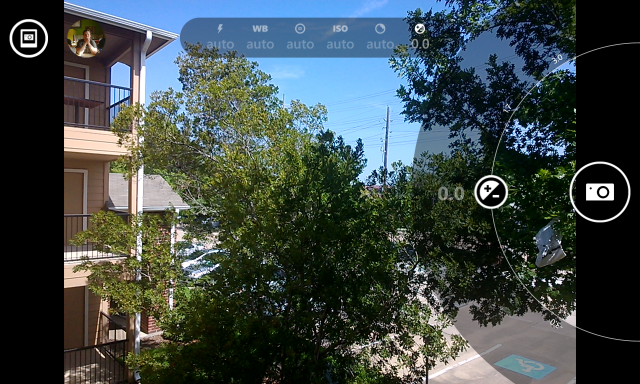
Within menus, there are also more advanced settings, such as bracketing, the display of optional grids to help frame images, and an option to store both the 5MP and full-resolution images or just the 5MP image.
When you have the full-resolution images, the app also allows ex post facto generation of new 5MP pictures to allow reframing and re-zooming on different parts of the image, creating new oversampled pictures.
This app is also used for recording video. It supports any combination of 1080p and 720p at any of 24, 25, and 30 Hz. Nokia claims it has two particular audio features that are important for video recording: extremely wide dynamic range and the ability to filter out any frequencies below 100Hz or 200Hz. The company claims that both of these make the Lumia 1020 much better at recording, for example, loud concerts. (Since I find live music generally objectionable, I haven't been able to put these claims to the test.)
Overall, it's a nice app, and I think the control mechanism works well. However, there's one issue: it's slow. The shot-to-shot time is slow, at perhaps two to three seconds. When trying to capture fast-moving action, this is a long time to wait. The standard camera app has the same issue.
I assume it's some consequence of the processing the Lumia 1020 has to perform. The old PureView 808 had an extra chip, a dedicated image processor, to handle its camera's high-resolution images.
The 1020 doesn't, instead using the main processor to do image processing duty. Qualcomm, which makes the processors in all the Windows Phones, says that the image processors on its chips support a maximum of 20 megapixels. The two companies have apparently come up with some software solution to make the extra megapixels work, but there appears to be a performance cost.
Nokia does have a solution of sorts. Its Smart Cam app will take rapid-fire pictures over the course of a few seconds, and it allows various trick options, such as compositing several pictures together or removing moving objects.
This isn't a general-purpose solution to the slow shot-to-shot time. Most of the time, one would want to use Pro Cam, as it's a better app for conventional photography. If you know that you'll want rapid-fire pics, Smart Cam does work. But I imagine that having to switch between apps—and having the wrong one open at the wrong time—will result in missed pictures.
Dumber software
As much as I like the on-phone software, there is one gap. In many regards, the phone's software only knows about the 5MP pictures. Automatic uploading to SkyDrive, for example, only works on the 5MP pictures. The same goes for Microsoft's own phone syncing tools for Windows.
Pro Cam knows about the full-size images to the extent that it allows you to construct new 5MP images from them, but it doesn't appear to actually expose them to let you put them on SkyDrive.
The only way I found to get direct access to the full-resolution pictures was to connect the phone to a PC and then browse it in Explorer. This works, and it's not a major impediment for working with the files in Lightroom or similar software. It's just not particularly obvious. It also means that the automatic photo backing up that the Windows syncing apps perform won't back up the high-res pictures.
Update: This might improve in the future, at least to some extent. Nokia has an imaging SDK for the Lumia 1020, and one of the things it provides is access to the full resolution pictures. One application that has been updated to use this SDK is AT&T's own cloud storage app, AT&T Locker. Locker can upload the high-resolution images.
Optional ergonomics
In common with other Windows Phones, the 1020 has a dedicated camera button that focuses on half press and takes the picture on full press, just like standalone cameras. But if you want something even more camera-like, Nokia has an optional camera grip accessory. Three, in fact—one in each color.
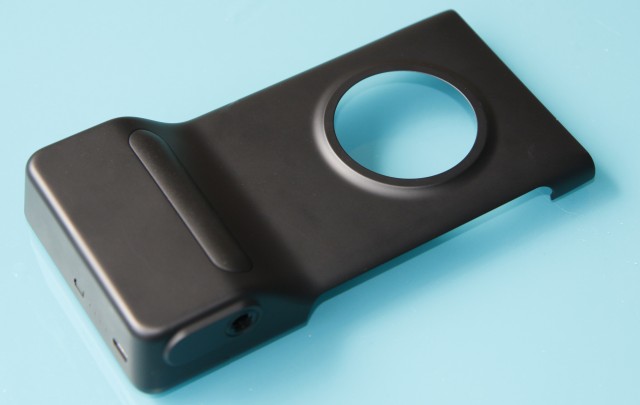
The camera grip.
This clips onto the phone and provides a bulge at the right-hand side, with a larger, more comfortable button. It makes the phone quite chunky—and the phone isn't small to start off—but when using the phone as a camera, it's more comfortable and far easier to hold steady. Instead of having to grip the phone delicately around its edges (an issue on pretty much every touchscreen phone), you can grab it firmly by the right hand side.
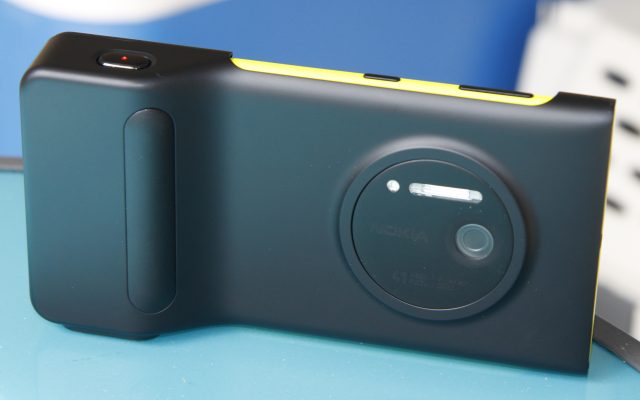
With the grip in place, it almost looks like a point-and-shoot.
It also further bolsters the Lumia camera credentials by adding a tripod mount. This isn't ideally positioned—it's below the bulky battery rather than below the lens—but it further extends the ways the camera can be used.
In addition to adding bulk, the grip adds weight: it includes an additional 1020 mAh battery that extends the life of the phone. There's a button on the end that lights up a set of LEDs to indicate how much charge is left in the grip.
From what I can tell, the grip sacrificially uses its battery to keep the phone's internal 2000 mAh battery topped off. Connect it, and the phone shows that it's charging with the battery at 100 percent capacity.
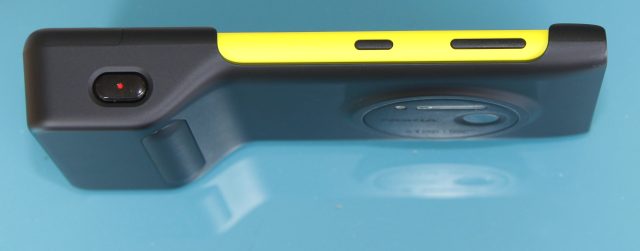
This is a little inelegant. I would like to see it engineered so that the software can tell me both the capacity of the internal battery and the camera grip battery.
I think the camera grip is an interesting idea. If I carried around my phone in a bag, it would be a no-brainer. Never mind the better photography ergonomics; it would be worth it for better battery life alone. Not because I had any particular problems with the 1020's battery life—it managed a fairly busy day of photography, casual Web browsing, light e-mailing, and so on—but because none of the phones I habitually use (Lumia 920, iPhone 5, Galaxy Nexus) can withstand a day of heavy usage with the screen on while I'm hammering the phone's network connection. More battery life is, therefore, always welcome.
But since I carry my phone around in my pocket, I'm not so sure. It's not the weight that bothers me (the grip adds another 72.8 g to the phone's 158 g) but the thickness. The thick part of the grip is 27.2 mm/1.07 inches. That's pretty damn chunky.
For some people, it's obviously too chunky. Me, my mind isn't made up. I don't wear skinny jeans and I have big pockets, so there's no problem with the size as such. I'm just not sure if I'd want to live with it.
Camera conclusions
There's no doubt that the camera in the Lumia 1020 is excellent. Nokia's engineering works, producing remarkable detail in good light and pulling out usable shots even in bad light. Oversampling is a sound technique, and the high-resolution makes digital zoom much more palatable.
The Pro Cam software is easy to use and effective as well. The camera grip makes handling the 1020 feel much more like handling a point-and-shoot. This is also to its credit, as long as you can tolerate the thickness it adds.
The only black mark is the shot-to-shot time. The delay between pictures is noticeable and will result in missing shots. It marred an otherwise impeccable camera experience. Other smartphones won't beat the picture quality of the Lumia 1020, but from time to time they might capture a picture that the 1020 misses entirely.
Amber update
The Lumia 1020 is equipped with Nokia's standard range of Windows Phone apps: the various "Here"-branded mapping/transport apps, including Drive+ with its turn-by-turn navigation. We looked at them when we reviewed the Lumia 928, and they're much the same now as they were then.
It also includes Nokia's various imaging apps. In addition to Pro Cam and Smart Cam, there's Creative Studio for performing various trick edits (fake tilt/shift effect, highlighting certain colors), Cinemagraph for making those animated "still" photos, a Panoramic picture maker, and a basic video editing app.
Like the 925—and coming to other Lumia models later this year—the phone also shows a clock when the screen is "off."
The core operating system hasn't changed substantially since we reviewed it last year. However, it's not quite identical. The Lumia 1020 ships with what Nokia calls the Amber update. For other Windows Phone 8 devices, it's called simply "GDR 2." (Amber includes a few Nokia-specific features not in GDR 2, such as the lock screen clock, but these differences should be fairly minor).
GDR 2 doesn't add anything too major. It reinstates FM radio support (except on the Lumia 620), a feature included in Windows Phone 7 but dropped in 8. It allows third-party camera applications to be used as the default camera app that gets invoked when you press the camera button—which is how the 1020 defaults to Pro Cam. And perhaps most significantly of all, it includes CalDAV and CardDAV support for syncing calendar items and contacts.
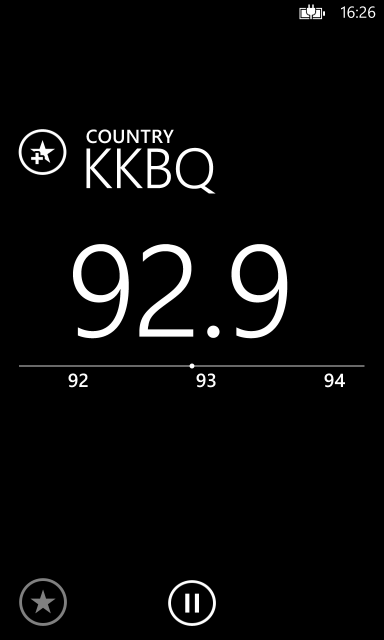
Here in Houston, the radio support lets me listen to both kinds of music.
This is important because of Google's decision to drop Exchange ActiveSync support on free mail accounts. Google retained support for an extra six months to give Microsoft time to develop CalDAV and CardDAV functionality for Windows Phone; GDR 2 is how that new functionality will be delivered to end users.
In GDR 2, Google accounts will no longer use Exchange ActiveSync. Instead, they rely on the trio of IMAP for mail, CalDAV, and CardDAV. Microsoft hasn't implemented support for IMAP IDLE, however. As a result, Gmail accounts won't support push mail. This will be a setback for any heavy Gmail users.
However, the new CalDAV and CardDAV support does appear to work correctly, so far as I can discern. There shouldn't be any worries about Gmail support breaking altogether.
As for third-party software, Windows Phone still has some big-name gaps. There's still no official Instagram app, for example. Nokia has promised that at least some of these gaps will be filled. Hipstamatic Oggl, the only third-party Instagram app that'sofficially allowed to upload pictures to the Facebook-owned photo sharing site, was released on Friday. Applications for the Vine short video service, Path social networking app, and Flipboard news reader are all promised, but they're not out yet.

If you insist on ruining your pictures with filters, Hipstamatic Oggl should do the job, I guess.
Then there’s the small matter of the price
If you want to use your smartphone as a camera, the Lumia 1020 is a fantastic choice. The camera works very well. The technology works well, and I liked it a lot. Nokia set out to make the best smartphone camera on the market, and the company has absolutely succeeded.
But there are three prices you pay for it.
The camera adds bulk. A little bit by default; quite a lot if you add the camera grip. It's still an awful lot less bulky than a smartphone and a separate camera, of course, but it's very much at the bulkier end of the smartphone spectrum. Personally, I can live with the bare phone. I'm still not sure about the camera grip, but the standalone phone is fine for my pockets. It might not be for yours. Different people have different tolerances for this kind of thing.
Second, the phone is exclusive to AT&T. If you want a different carrier, you're out of luck. I don't think we know what the roll-out will be like beyond the US's borders yet, but I would put money on there being more exclusive arrangements of one kind or another. I prefer T-Mobile's call plans (breaking out the phone payment from the call plan is more transparent and, for my purposes, quite a bit cheaper) and I wouldn't switch to a different network just for a phone, even if I really liked the phone.
Third, the phone is just plain expensive. On a two-year contract with AT&T, it cost $299.99 up front with a minimum of $59.99 per month. And that's just for 300MB of data. 3GB per month will add another $10. Buy the phone off contract and it's $659.99. Other phones from AT&T attract a bigger subsidy. The 16GB Galaxy S4, for example, costs slightly less off contract—$639.99—but it can be had on a two-year contract for just $199.99. The 16GB iPhone 5 is similar: $649.99 off contract or $199.99 on a two-year contract.
In other words, the Lumia 1020 will cost an extra $100. It's not clear to me why the on-contract price should be so different given that no such discrepancy in the off-contract price exists. But thanks to the AT&T exclusivity, the options are to accept the pricing or buy a different phone entirely.
Unlocked and available on any network, I think the Lumia 1020 would be easy to recommend. But the price and exclusivity makes it a much trickier proposition. If I used AT&T anyway, I would go for it. But I wouldn't switch networks for this phone—or any other.
The Good
- That camera
- With the grip, it even feels like a camera
- I continue to enjoy Windows Phone
The Bad
- That bulge
- With the grip, it's pretty huge
- Windows Phone today is barely changed from Windows Phone as it was 9 months ago
The ugly
- That price
Thanks for sharing information
ReplyDeleteChoose from a variety of 2.75G prepaid and 2.75G postpaid internet plans for 2.75G recharge Video calls if successful will be charged as per the visited network tariff.
Cool and that i have a swell give: How Much House Renovation Cost remodel outside of house
ReplyDelete